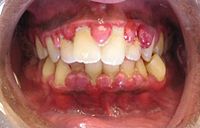
Photo from wikipedia
AIM To report the evidence on the effect of mechanical and/or chemical plaque control in the simultaneous management of gingivitis and caries. MATERIAL AND METHODS A protocol was designed to… Click to show full abstract
AIM To report the evidence on the effect of mechanical and/or chemical plaque control in the simultaneous management of gingivitis and caries. MATERIAL AND METHODS A protocol was designed to identify randomized (RCTs) and controlled (CCTs) clinical trials, cohort studies and prospective case series (PCS), with at least 6 months of follow-up, reporting on plaque, gingivitis and caries. Relevant information was extracted from full papers, including quality and risk of bias. Meta-analyses were performed whenever possible. RESULTS After the screening of 1,373 titles, 15 RCTs, 10 CCTs and 2 PCS were included. Low to moderate evidence support that combined professional and self-performed mechanical plaque control significantly reduces standardized plaque index [n = 4; weighted mean difference (WMD) = 1.294; 95% CI (0.445; 2.144); p = 0.003] and gingivitis scores [n = 4; WMD = 1.728; 95% CI (0.631; 2.825); p = 0.002]. The addition of fluoride to mechanical plaque control is relevant for caries management [n = 5; WMD = 1.159; 95% CI (0.145; 2.172); p = 0.025] while chlorhexidine rinses are relevant for gingivitis. CONCLUSION Mechanical plaque control procedures are effective in reducing plaque and gingivitis. The addition of fluoride to mechanical plaque control is significant for caries management. Chlorhexidine rinse has a positive effect on gingivitis and inconclusive role in caries.
Journal Title: Journal of Clinical Periodontology
Year Published: 2017
Link to full text (if available)
Share on Social Media: Sign Up to like & get
recommendations!